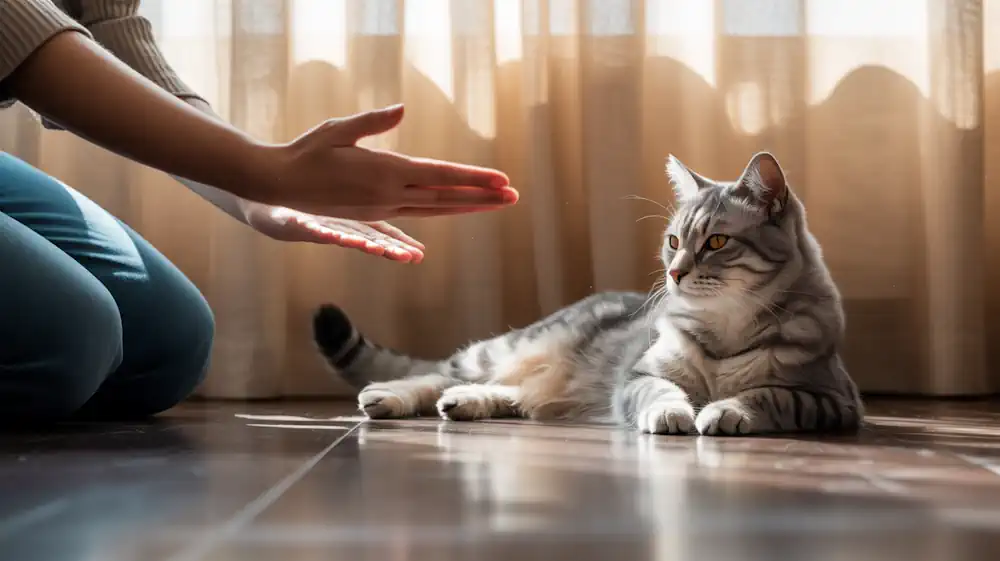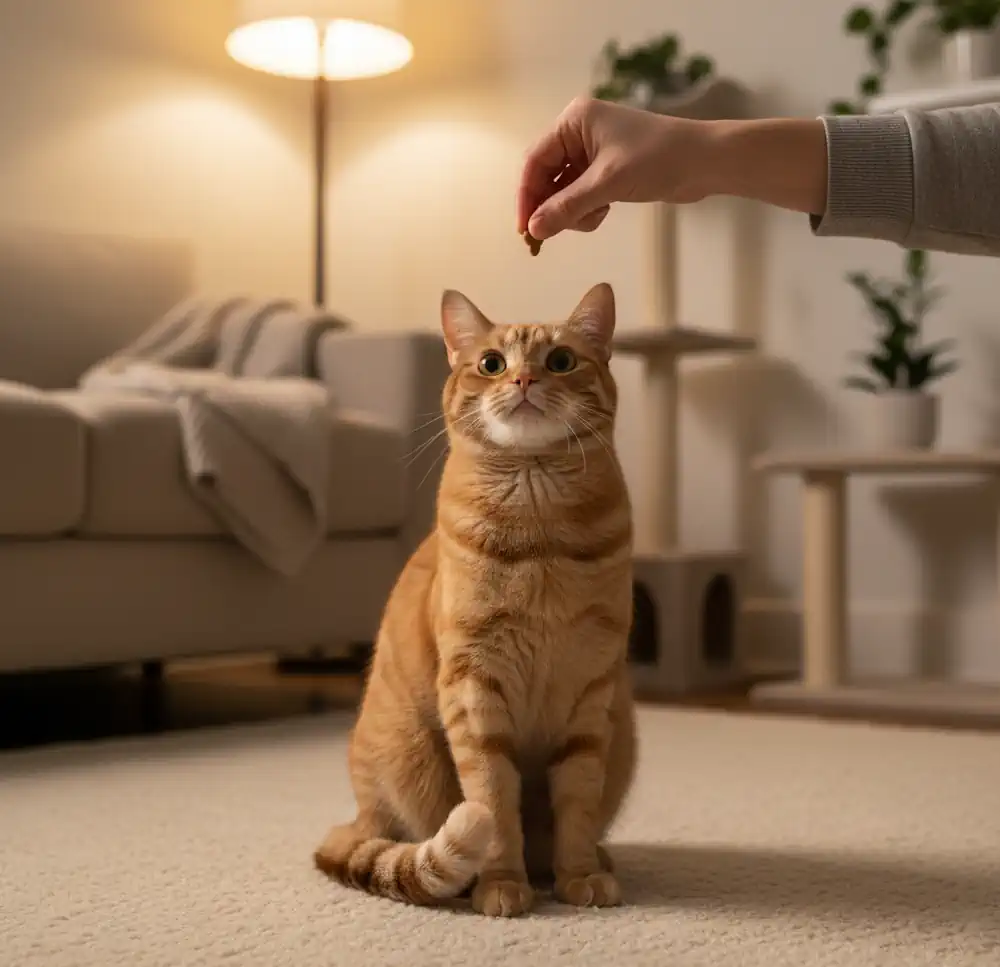Most people approach cat training with the same mindset they’d use for dogs: repeat the command, give the reward, repeat again until it sticks. On paper, it makes sense. In practice, it usually collapses. The cat loses interest. The human gets impatient. The training stalls.

Here’s the overlooked truth: cats don’t learn best through repetition. They learn through dopamine – the brain’s chemical messenger of motivation, reward, and novelty.
Understanding this one principle flips training from a battle of wills into a surprisingly fast and enjoyable process.
The Myth of Repetition
Repetition has long been sold as the foundation of training. But repetition only works if the brain continues to pay attention. Cats, like humans, are highly efficient. Once they can predict what’s coming, the brain turns down its learning circuits.
Neuroscience research shows that when the brain encounters the same stimulus over and over, dopamine levels decrease. The message is clear: “This is predictable. Nothing new here. No need to waste energy remembering.”
That’s why, after the third or fourth time you repeat a command, your cat suddenly “zones out.” It’s not disobedience – it’s biology. Their brain has stopped logging the information.
Dopamine: The Brain’s Learning Accelerator
Dopamine isn’t just a “feel-good” chemical. It’s a motivational engine. It fires when something feels novel, rewarding, or better than expected. In the brain, dopamine acts like a highlighter pen, marking specific moments as “important, remember this.”
In cats, dopamine surges in the striatum, the area that controls habit formation and reinforcement learning. This means behaviors linked with dopamine spikes are much more likely to stick.
A surprising reward (a treat they didn’t see coming, or a sudden burst of play) triggers a stronger dopamine release than something expected. That surge strengthens neural pathways, encoding the behavior more quickly and more permanently than repetition ever could.
This is why one moment of surprise-and-reward can be more effective than ten rote drills.

The Psychology of Curiosity in Cats
Cats are natural explorers. Their survival as hunters depends on curiosity; the drive to investigate what might be food, threat, or opportunity. This is why they jump into boxes, paw at shadows, or inspect bags you’ve just brought home.
Training works best when it taps into this same psychological drive. When a training session feels like play or exploration, the cat stays engaged. When it feels predictable or mechanical, curiosity dies, and so does learning.
The key is variability. Change the timing. Change the rewards. Change the environment. The moment your cat thinks, “What will happen this time?” dopamine fires, attention sharpens, and the learning circuit switches on.

Why Punishment Fails Completely
Many frustrated cat owners resort to punishment methods, such as using spray bottles, making loud noises, or scolding. But this backfires at the brain level. Stress hormones like cortisol flood the cat’s system, which actively suppresses learning by shrinking dendritic connections in the prefrontal cortex (the tiny branch-like pathways that help the decision-making part of the brain communicate with other brain areas).
The cat doesn’t learn not to do the behavior. Instead, it learns not to trust the trainer. The relationship suffers, and future training becomes harder.

Dopamine-based learning, in contrast, strengthens trust. It tells the cat: engaging with you brings surprise and delight. This builds not just trained behaviors, but a cooperative bond.
A Practical Framework: Training With Dopamine in Mind
If repetition is out, what works? Here’s a step-by-step framework based on the neuroscience of dopamine:
1. Break Predictability
Never reward the same way twice in a row. Rotate between food, play, affection, or even a “jackpot” reward – a sudden burst of multiple treats. This unpredictability keeps dopamine levels high.
2. Train in Short Bursts
Sessions should last two to three minutes. Past that, dopamine drops and engagement fades. Stop while your cat is still curious, not after they’ve checked out.
3. Use Context Shifts
If a cat only learns “sit” in the kitchen, it’s because their memory is tied to that environment. Train in different rooms, at different times of day, to create flexible, context-independent learning.
4. Add Novelty Every Time
Introduce small variations: a new toy, a different hand signal, or a fresh treat. Even minor changes trigger dopamine.
5. End on a High
Stop training while the cat is still engaged. This locks in a positive emotional memory, making the cat eager for the next session.
The Deeper Shift: From Obedience to Wonder
The traditional framing of training is obedience: the human issues a command, the animal complies. But cats are not wired for blind obedience. Their brains are wired for curiosity, exploration, and reward prediction.
Training through dopamine respects this truth. It reframes the process from control to collaboration. Instead of grinding in behaviors through repetition, you’re creating small moments of surprise that the cat’s brain wants to remember.
This philosophical shift changes everything. Training is no longer about bending the cat to your will; it’s about aligning with how their brain naturally learns.

Teaching Your Cat to Sit
Here’s a simple, step-by-step way to teach a cat to sit using the dopamine method:
Step 1: Get Set Up
- Have a few different treats ready; some favorite ones, some regular ones, and maybe a “jackpot” treat, like tuna and chicken.
- Keep an assortment of toys nearby for play breaks.
Step 2: Lure the Sit
- Hold a treat just above your cat’s nose.
- Slowly move the treat up and slightly back over their head.
- Most cats will naturally tuck their hips and sit down to keep watching the treat.
Step 3: Mark the Behavior
- The moment the butt touches the ground, say “Sit.”
- Keep your timing tight, reward within 1 second.
Step 4: Give the Reward
- Offer one of the rewards you prepared, sometimes a treat, sometimes a play session with a toy, sometimes praise and some cuddles.
- Vary it so your cat stays curious: food one time, a toy the next, maybe a jackpot for an especially quick sit.
Step 5: Keep it Short
- Do just a few repetitions (3–5).
- End the session while your cat is still engaged, not when they’re bored.
What This Means for the Future of Cat Training
Science is rewriting the playbook. For decades, repetition has been the default training method across animals. But with cats, dopamine offers a faster, more humane, and more effective path.
Imagine a future where training sessions are not battles of patience, but bursts of play. Where cats master behaviors quickly because their brains are engaged, not bored. Where trust deepens because training is built on positive surprises, not punishments.
That future is already here – if you’re willing to train in the language the cat’s brain actually speaks.

A Smarter Way Forward
Cats don’t learn through endless drills. They learn through dopamine spikes – moments of novelty, surprise, and reward that light up the brain’s learning circuits.
If you shift from repetition to dopamine-driven training, you’ll discover something surprising yourself: cats are not difficult to train at all. They were ready all along.
They just needed you to unlock the right switch in their brain.

